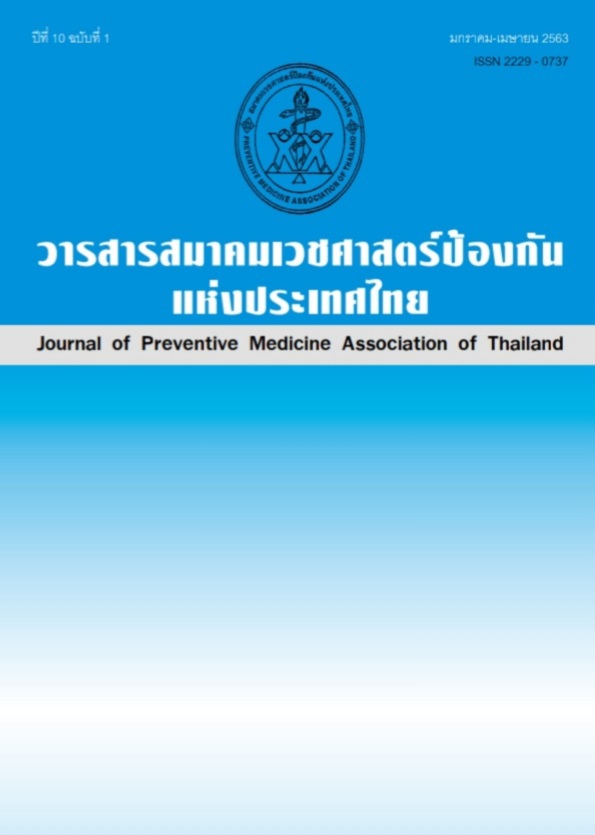Quality of life in palliative end-stage renal disease patients in Phra Nakhon Si Ayutthaya Hospital
Keywords:
Quality of life, End-stage renal disease, Palliative, Non-dialysisAbstract
This descriptive research aimed to study quality of life in palliative end-stage renal disease (ESRD) patients in Phra Nakhon Si Ayutthaya Hospital. The samples were 30 palliative ESRD patients. The research instruments consisted of a questionnaire of personal characteristics and the Quality of Life Questionnaire for Chronic Kidney Disease (Kidney Disease Quality of Life Short Form: KDQOL-SFTM version 1.3) in Thai language. Data were collected from October to December 2019. Statistics used for data analysis included frequency, percentage, mean, standard deviation, median, maximum and minimum. The research results revealed that palliative ESRD patients in Phra Nakhon Si Ayutthaya Hospital had median of age (yrs.)=71.5 (Max-Min=46-93), median of renal function (eGFR)=9.05 (Max-Min=2.50–14.92), the mean of overall quality of life scores was at high level (=70.9, SD=15.4672). In consideration of the overall quality of life of the sample as an individual, the two most frequent overall quality of life scores were in high level (33.3%), and followed by in very high level (26.7%). In conclusion, the ESRD patients can still have a good quality of life, even treated with conservative treatment without kidney replacement therapy. The findings from this research shall be utilized to jointly work among multidisciplinary to exchange experience and enhance practical knowledge in ESRD to raise the knowledge for patients and caregivers. In the policy level, the principle of palliative care in ESRD patients should be educated to the nephrology nurses so they can provide palliative care instructions and integrate the patient care between the chronic kidney disease clinic and the palliative care clinic.
References
2. สำนักนโยบายและยุทธศาสตร์ กระทรวงสาธารณสุข. จำนวนผู้ป่วยโรคไตเรื้อรังที่มารับบริการที่โรงพยาบาลปีงบประมาณ 2561. นนทบุรี: สำนักนโยบายและยุทธศาสตร์ กระทรวงสาธารณสุข; 2562.
3. Murtagh FE, Addington-Hall JM, Edmonds PM, Donohoe P, Carey I, Jenkins K, et al. Symptoms in advanced renal disease: a cross-sectional survey of symptom prevalence in stage 5 chronic kidney disease managed without dialysis. J Palliat Med 2007;10:1266-76.
4. สมาคมโรคไตแห่งประเทศไทย. คำแนะนำสำหรับการดูแลผู้ป่วยโรคไตเรื้อรัง ก่อนการบำบัดทดแทนไต พ.ศ. 2558. กรุงเทพฯ: สมาคมโรคไตแห่งประเทศไทย; 2558.
5. สำนักงานหลักประกันสุขภาพแห่งชาติ. คู่มือบริหารกองทุนหลักประกันสุขภาพแห่งชาติ ปีงบประมาณ 2560 การบริหารงบบริการผู้ป่วยไตวายเรื้อรัง. กรุงเทพฯ: สำนักงานหลักประกันสุขภาพแห่งชาติ; 2559.
6. คณะอนุกรรมการการลงทะเบียนการบำบัดทดแทนไตในประเทศไทย. Thailand renal replacement therapy: Year 2015. กรุงเทพฯ: สมาคมโรคไตแห่งประเทศไทย; 2558.
7. Hussain JA, Mooney A, Russon L. Comparison of survival analysis and palliative care involvement in patients aged over 70 years choosing conservative management or renal replacement therapy in advanced chronic kidney disease. Palliat Med 2013;27:829-39.
8. Chandna SM, Da Silva-Gane M, Marshall C, Warwicker P, Greenwood RN, Farrington K. Survival of elderly patients with stage 5 CKD: comparison of conservative management and renal replacement therapy. Nephrol Dial Transplant 2011;26:1608-14.
9. Verberne WR, Geers AB, Jellema WT, Vincent HH, van Delden JJ, Bos WJ. Comparative Survival among Older Adults with Advanced Kidney Disease Managed Conservatively Versus with Dialysis. Clin J Am Soc Nephrol 2016;11:633-40.
10. Carson RC, Juszczak M, Davenport A, Burns A. Is maximum conservative management an equivalent treatment option to dialysis for elderly patients with significant comorbid disease? Clin J Am Soc Nephrol 2009;4:1611-9.
11. สมาคมโรคไตแห่งประเทศไทย. คำแนะนำสำหรับการดูแลผู้ป่วยโรคไตเรื้อรังแบบองค์รวมชนิดประคับประคอง พ.ศ. 2560. กรุงเทพฯ: สมาคมโรคไตแห่งประเทศไทย; 2560.
12. Yong DS, Kwok AO, Wong DM, Suen MH, Chen WT, Tse DMW. Symptom burden and quality of life in end-stage renal disease: A study of 179 patients on dialysis and palliative care. Palliat Med 2009;23:111-9.
13. Brown MA, Collett GK, Josland EA, Foote C, Li Q, Brennan FP. CKD in elderly patients managed without dialysis: Survival, symptoms, and quality of life. Clin Am Soc Nephrol 2015;10:260-8.
14. Iyasere O, Brown EA, Johansson L, Davenport A, Farrington K, Maxwell AP, et al. Quality of life with conservative care compared with assisted peritoneal dialysis and haemodialysis. Clin Kidney J 2018;12:262-8.
15. Da Silva-Gane M, Wellsted D, Greenshields H, Norton S, Chandna SM, Farrington K. Quality of life and survival in patients with advanced kidney failure managed conservatively or by dialysis. Clin J Am Soc Nephrol 2012;7:2002-9.
16. อำนวยพร แดงสีบัว, อัจฉราวรรณ โตภาคงาม, สัจจะ ตติยานุพันธ์วงศ์, จุฬาภรณ์ ลิมวัฒนานนท์. การติดตามผู้ป่วยโรคไตเรื้อรังระยะที่ 5 ที่เลือกรับการรักษาแบบไม่ฟอกไต. วารสารวิจัยระบบสาธารณสุข 2558;9:181-92.
17. จำรัส สาระขวัญ, สุนทรี สิทธิสงคราม, มาลินี บุญเกิด. คุณภาพชีวิตผู้ป่วยโรคไตเรื้อรังระยะสุดท้าย. วารสารวิทยาลัยพยาบาลพระปกเกล้า จันทบุรี 2560;28:153-64.
18. นลิตา เหลาแหลม, พรมมินทร์ ไกรยสินธ์, วัชรียา ปาละกุล, อภิรดา ฉิมพาลี, กัตติกา หาลือ, วีระพล จันทร์ดียิ่ง. ประเมินคุณภาพชีวิตระหว่างผู้ป่วยฟอกเลือดล้างไตและล้างไตทางช่องท้อง ณ โรงพยาบาลพะเยา. วารสารนเรศวรพะเยา 2557;7:172-77.
19. วงศ์ทิพารัตน์ มัณยานนท์, อรอนงค์ วลีขจรเลิศ, ธนนรรจ์ รัตนโชติพานิช. การทดสอบคุณสมบัติการวัดเชิงจิตวิทยาของแบบวัดคุณภาพชีวิตผู้ป่วยโรคไต (KDQOL-SFTM) ฉบับภาษาไทย. วารสารเภสัชกรรมไทย 2553;2:15-23.
20. ขนิษฐา หอมจีน, พรรณทิพา ศักดิ์ทอง. การแปลและทดสอบกระบวนการคิดของแบบสอบถามคุณภาพชีวิตโรคไตฉบับย่อภาษาไทย เวอร์ชั่น 1.3. วารสารเภสัชกรรมไทย 2553;2:3-14.
21. จำรัส สาระขวัญ, สุนทรี สิทธิสงคราม, มาลินี บุญเกิด. คุณภาพชีวิตผู้ป่วยโรคไตเรื้อรังระยะสุดท้าย. วารสารวิทยาลัยพยาบาลพระปกเกล้า จันทบุรี 2560;28:153-64.
Downloads
Published
How to Cite
Issue
Section
License
บทความที่ลงพิมพ์ในวารสารเวชศาสตร์ป้องกันแห่งประเทศไทย ถือเป็นผลงานวิชาการ งานวิจัย วิเคราะห์ วิจารณ์ เป็นความเห็นส่วนตัวของผู้นิพนธ์ กองบรรณาธิการไม่จำเป็นต้องเห็นด้วยเสมอไปและผู้นิพนธ์จะต้องรับผิดชอบต่อบทความของตนเอง






